Martin Edwards's Blog, page 76
April 19, 2021
Len Tyler - The New Detectives' Decalogue - part one
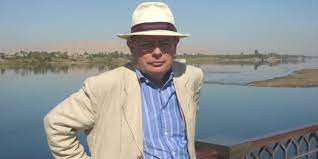
I first came across L.C. Tyler's fiction when I read and reviewed The Herring-Seller's Apprentice. This amusing mystery introduced luckless detective novelist Ethelred Tressider and his fearsome agent Elsie Thirkettle. I was greatly entertained and I've enjoyed the series ever since. Happily, Len is this week publishing another entry in the series, Farewell My Herring. To celebrate, he has kindly written a guest post specially for this blog. Today I'll post the first part,.leaving Len's revised Decalogue as a treat in store for Wednesday. Over to you, Len...
' When I wrote my first book, many years ago now, I thought I’d just written a novel. It was only when my publisher started marketing it as crime fiction that I accepted that writing about murder made me eligible to join the Crime Writers' Association, and indeed later to become its Chair. When I attended my first crime conference I was faced with a supplementary question: what sort of crime writer was I? It apparently dictated whether I was on the ‘Can You Ever Have Too Much Blood and Gore?’ panel or the ‘Quilt-makers Who Kill’ panel. I have always rejected the label of ‘cosy crime’ (unless speaking to an audience who only ever bought craft-based mysteries). I would probably describe what I do as comic crime or, better still, traditional crime. My ‘Herring' (aka Ethelred and Elsie) books look back, very consciously, to the Golden Age, its conventions and its rules.
In Farewell My Herring, my two protagonists find themselves teaching on a seminar for writers of traditional crime fiction, at a remote location in the north of England. When the least offensive participant on the course is found strangled in the woodshed, and a snowstorm cuts the party off from the rest of the world, my two amateur detectives are obliged to investigate. As you do.
The subject and the setting made me, of course, reflect a great deal on exactly what I mean by traditional crime fiction. And for those enjoy such things, Farewell My Herringdoes contain a certain amount of discussion of the genre generally. The ten rules of Golden Age fiction were famously tabulated by Ronald Knox in 1928 and have been much quoted and parodied ever since - including on this blog (). They also form the framework of my chapter in the Detection Club’s collaborative mystery, The Sinking Admiral. This ‘Decalogue’ stresses ‘fair play' and includes some very reasonable stipulations such as ‘the criminal must be mentioned in the early part of the story, but must not be anyone whose thoughts the reader has been allowed to know’. It also includes the slightly quirkier ‘no hitherto undiscovered poisons may be used, nor any appliance which will need a long scientific explanation at the end’ and ‘twin brothers, and doubles generally, must not appear unless we have been duly prepared for them’. Some rules, like ‘the detective himself must not commit the crime’ have been frequently and successfully broken.
It is clear however that the Decalogue needs updating to reflect what we mean by traditional crime fiction today...'
To be continued!
April 16, 2021
Forgotten Book - The Crime of Colin Wise

Michael Underwood was a self-effacing man, most of whose books reflected his interest in and knowledge of the law. The people I've spoken to who knew him regarded him as a likeable chap as well as a dependable writer, as this obituary by Harry Keating in The Independent indicates. To an even greater degree than his fellow lawyer Michael Gilbert, he preferred not to put much of his own personality into his fiction, and this may help to explain why he never became a high-profile writer.
I recently acquired a copy of The Crime of Colin Wise that he inscribed to some friends in the year of publication, 1964. The dust jacket blurb describes it as 'certainly the most intriguing and perhaps the most unusual crime story Michael Underwood has yet written'. It's an inverted story, told from the viewpoint of Colin Wise himself. Colin is a young man who works for a TV repair company (ah, those were the days, or perhaps not...) and who, when the story begins, has decided to commit murder for money.
His intended victim is an author who is about to embark on a six-month trip overseas. Colin's cunning plan is to kill him, hide the body parts (after dismembering the chap in the bath) and then take control of his finances. At first the plan goes well, but it soon becomes clear that Colin's crime is far from being a perfect murder.
I always find that Underwood keeps me reading, because his prose, although undramatic, is fluent. The story is interesting, because although we feel sure that things won't go smoothly for Colin, what exactly will happen to him is unclear. There are trial scenes and, as you would expect, these are handled authoritatively. Not does the story outstay its welcome. So I read the book quickly and with genuine and sustained interest.
My main reservation is that Colin himself is deeply unappealing. He's selfish and has few redeeming qualities. Compare Dr Bickleigh in Francis Iles' Malice Aforethought or the protagonists in Julian Symons' The Man Who Killed Himself and The Man Whose Dreams Came True. Those individuals also get involved in terrible crimes, but the authors persuade the reader to feel at least a degree of kinship with them. dreadful as they are. That is more than one feels for sociopathic Colin. And those books also had a superb ironic twist. Underwood contrives a twist at the end of his book, but because it hasn't been foreshadowed, I felt it didn't have as much impact as it should have done. Sometimes you can be too low-key.
April 14, 2021
Many Deadly Returns - the new Murder Squad anthology
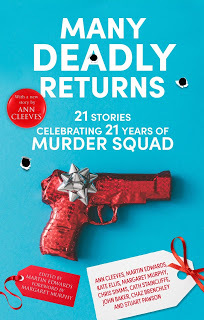
None of us can quite believe it, but it's 21 years since Margaret Murphy formed Murder Squad, a group of northern crime writers, and if ever there was an anniversary worth celebrating, we reckon this it! (Especially since we were denied the chance to celebrate our 20th birthday by the pandemic). The cornerstone of those celebrations this year will be the publication of an exciting new anthology, Many Deadly Returns, which will be published by Severn House on 26 August.
Appropriately enough, there are no fewer than 21 stories in the book, a nice mix of brand new stories and examples of our work from the past that you may well not be familiar with. There are three stories written by each of the Squad's current members: Margaret, Ann Cleeves, Chris Simms, Cath Staincliffe, Kate Ellis, and me. And there is also a story from each of our three former members: Chaz Brenchley, John Baker, and the late Stuart Pawson. I've edited the book and there's a foreword by Margaret.
So, what of the stories? Well, a dawn swim turns deadly in a brand-new short story starring DI Vera Stanhope . . . Two bored cell-mates play a game with chilling results . . . A hen night in an isolated cottage brings new meaning to ‘I will survive’ . . . A train traveller teaches a valuable lesson in reading labels . . . A day at the seaside turns stormy for a woman who doesn’t care for foreigners . . . A wealthy retiree makes a new friend who connects her to the Other Side . . . and much much more.
Murder Squad has been an important part of my life throughout those 21 years. It's a great pleasure to collaborate with such lovely people and during our time together there have been many wonderful occasions. And a few good anthologies too! We hope readers everywhere will enjoy this one.
April 12, 2021
The Man with My Face - 1951 film review
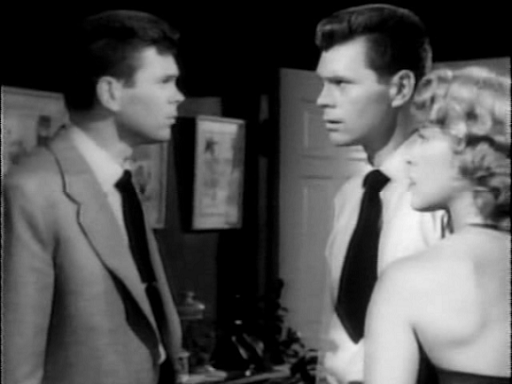
We tend to associate film noir with urban settings and dark, menacing streets. This isn't surprising, but there are a number of sunlit films which fit into this genre of movie-making. The outstanding example is Body Heat, sometimes described as neo-noir. And then there is The Man with My Face, a modest but competent film set in Puerto Rico.
I spent a few days in Puerto Rico some years ago, and really liked the place. The film is black and white, but I enjoyed recognising one or two locations from my own trip. However, the main appeal of the movie lies in its excellent premise, which is definitely worthy of Cornell Woolrich. Charles Graham (Barry Nelson) goes home one day and finds his wife, brother-in-law, and dog in the company of another man - who looks identical to him. And they insist that the stranger is Graham, and that the chap who has just come home is an impostor. The dog even bites him.
The secret behind this dazzling situation doesn't involve identical twins, you'll be pleased to know. It is, however, revealed relatively quickly, which I thought rather a shame. The story develops competently, and there is an exciting climax, but I certainly wouldn't claim this as a masterpiece. Nelson is a likeable actor but isn't quite engaging enough for this role, in my opinion . I was pretty surprised to learn that he was the very first actor to play James Bond. The rest of the cast is at the same level - okay, but not brilliant - and the same can be said of the screenplay.
Samuel W. Taylor wrote the novel (which was published in the UK as a green Penguin in the Fifties. and is still quite easy to find) on which the film is based and was one of those who worked on the screenplay. The book is set in California, and I'm not sure of the reason for the change of setting, but it works really well. I think more could have been made of such a superb premise, and certainly Graham's terrifying situation could have been conveyed in a more chilling way. Never mind, despite the film's limited ambitions, I enjoyed watching it.
April 9, 2021
Forgotten Book - Death Goes to School
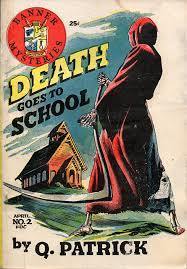
Death Goes to School was first published in 1936, under the pen-name Q. Patrick. My copy is a 'Banner Mystery' paperback from 1945, as per the image above. According to the invaluble online resource Crime, Mystery & Gangster Fiction Magazine Index, this imprint, edited by Ken Crossen, extended to just two publications. This was the second, but the story itself can't be the reason that Banner folded up. Although this is far from the best of the Q.Patrick stories, it's not bad.
The Banner version of the book is so slim that I wondered if the original novel was abridged. This seems, however, not to be the case. And if the story had been any longer, it would have outstayed its welcome. The length of this version seems right for the ingredients of the story and the number of possible suspects (which is very limited, and I think a significant failing).
This is one of many Golden Age detective stories set in a fee-paying school. (I've never, ever read a novel written during the 1930s which is set in a grammar school). Indeed, the two murder victims in the story (others die off-stage) are children, and one of the crimes has an especially macabre flavour. The setting is England, but there are a number of American characters, and the story has its roots in the United States.
Online sources disagree as to the precise authorship of the book, but it seems pretty clear that it was written by Richard Wilson Webb, while Curtis Evans has suggested that his future collaborator Hugh Wheeler may have had some input, prior to Webb and Wheeler becoming a fully-fledged writing partnership. Both Webb and Wheeler were Englishmen who moved to the US. The build-up is so-so, in my opinion, because I didn't find the characters or indeed the central mystery especially engaging. But the weaknesses are redeemed in the later chapters as the pace hots up and there are one or two pleasing plot twists.
April 7, 2021
British Library Crime Classics - Looking Ahead
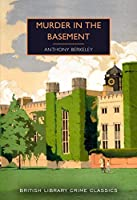
The British Library Crime Classics series continues to go from strength to strength. This is more of an achievement than it may seem, given that sales have been extremely strong in Britain and elsewhere for the past six or seven years. But the series has benefited enormously from the enthusiasm of booksellers, both a large number of marvellous indies and also the likes of Waterstones and Heffers. With the shops shut, many new books have suffered accordingly. The Crime Classics paperbacks, with their very popular artwork, have attracted a lot of interest from shop browsers. Thankfully, ebook sales have been excellent. while to the best of my knowledge, paperback sales have held up better than one might have expected. Much credit is due to the BL's publications department, who have kept things going even when the Library itself has been closed to the public - it's over sixteen months since I was last there.
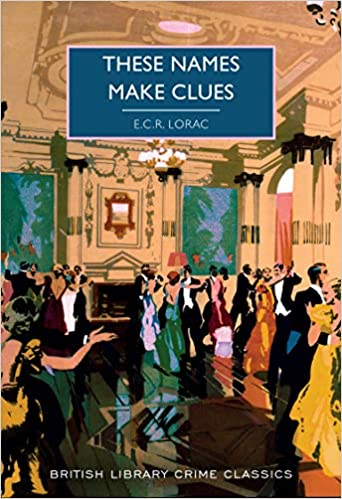
And now the Crime Classics to be published in the second half of this year have been announced. I think it's a great list, with some personal favourites of mine .These include E.C.R. Lorac's These Names Make Clues, which along with Bats in the Belfry is probably my favourite of her books - though the standard is pretty even, so it is hard to choose. A real gem is John Dickson Carr's excellent Till Death Us Do Part.
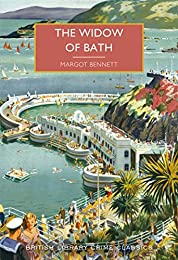
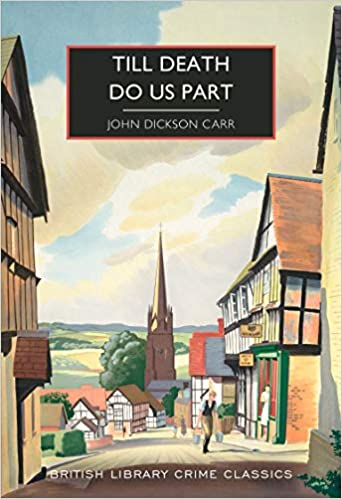
There are two books which, interestingly, I enjoyed more the second time I read them than first time around. I think that's probably because to some extent both of them weren't quite what I expected. One is Margot Bennett's The Widow of Bath, which is very witty and well-written, and also cunningly plotted. Another is Anthony Berkeley's 'whowasdunin', the under-estimated Murder in the Basement.
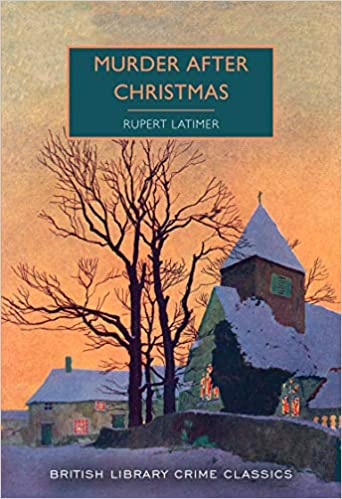
One book the BL, rather than I, discovered was Rupert Latimer's Murder after Christmas. I'm sure I'll say more about that one nearer to the festive season. And there will also be another of my own anthologies, this time with a book-related theme. The precise contents and indeed the title are still being considered by the BL in the light of my various suggestions - I can't imagine it will be possible to include everything that I put forward, for reasons of space, but this will be an eclectic collection and, I like to think, will offer a great deal of entertainment.
April 5, 2021
Street of Chance - 1942 film review
The first Cornell Woolrich novel I read, back in the early 1980s, was The Black Curtain. It happened to be the first Woolrich book that was filmed. The movie version was called Street of Chance, and many more film adaptations of Woolrich novels and stories followed. His storylines were highly cinematic, with hapless protagonists facing nightmarish dilemmas and dangers. Street of Chance is a good example.
Debris falling from a building in New York City hits Frank Thompson (Burgess Meredith) as he is passing by. When he recovers consciousness, he is disconcerted to find that his hat and cigarette case are marked with unfamiliar initials. He goes back home to discover that his wife Virginia (Louise Platt) has moved. When he tracks her down, she reveals that he has been missing for five years...
Yes, this is an amnesia story, and a good one. Frank soon finds himself pursued by an aggressive and violent man, and goes on the run. Before long he discovers that while he was out of himself he took another name and identity and got involved with Ruth Dillon (Claire Trevor), a maid to the wealthy Diedrich family. Unfortunately he is suspected of having murdered Harry Diedrich, and is being hunted by the police.
Is he guilty of the crime or can he prove his innocence? The beauty of Woolrich's fiction is that, because he wrote stand-alones rather than novels with a series character, one can never be entirely confident that the protagonist will survive unscathed. Meredith does a first-class job as an ordinary guy thrust into a life-or-death drama and the film zings along at a satisfactory pace until the final climax. An early essay in film noir, it stands the test of time really well.
April 2, 2021
Forgotten Book - The End of Solomon Grundy
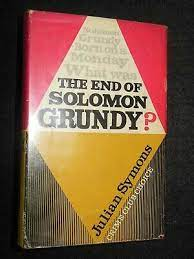
Julian Symons published The End of Solomon Grundy in 1964 and I first read it a few years later, after borrowing from the local library an omnibus of three of his novels. I must have been about fourteen or so at the time. Having exhausted the works of Christie and Sayers, I was venturing into what was then contemporary, cutting-edge crime. As I later learned, this book was one of Symons' own favourites, though I had mixed feelings about it. I'm now glad to have the copy Symons inscribed to his friend and fellow crime writer George Sims, but half a century later some misgivings remain.
Symons was interested in social satire, and there's a good deal of that in the first part of the book. Along the way, he tackled various burning issues of the time, including suburban housing, racism, sexual mores, and homophobia. So the book casts very interesting light on progressive thinking of the time. I'm pretty sure that when I read it at a tender age, some of the points Symons were making went over my head. And of course, what was progressive then is not so progressive now, and today the book seems much more dated than some of Symons' other novels written in the Sixties. As a document of social history, however, it does have considerable fascination.
The main setting is The Dell, an upmarket housing estate which Symons based on a real-life development near his one-time home in Blackheath. There is a disruptive figure in The Dell, namely a ginger-headed Irishman called Solomon Grundy. He's lived there for some years, and is a successful commercial artist, but his marriage isn't faring too well and his temper is apt to fray.
At a party, Grundy has an encounter with a young woman, who claims he attacked her. Subsequently, she is found dead. Who has killed her? Grundy becomes the prime suspect and there's plenty of circumstantial evidence to suggest his guilt. There is a trial, described at length, which features Magnus Newton QC, the criminal lawyer who had appeared in some of Symons' earlier books.
As always, Symons writes very engagingly. I enjoy reading him, as I enjoy reading such different writers as Michael Gilbert, Peter Lovesey, Reg Hill, and Robert Barnard. Their prose is lively and witty, their puzzles unorthodox, their stories always highly readable. But The End of Solomon Grundy isn't one of my favourite Symons mysteries. The plot felt rather anti-climactic when I first read the book, and it still does. And although Symons was focusing on psychology, I'm not convinced that he really captured the key relationships between his characters in adequate or convincing psychological depth. Beta plus, rather than an alpha.
March 31, 2021
More than Malice and the Agatha Awards
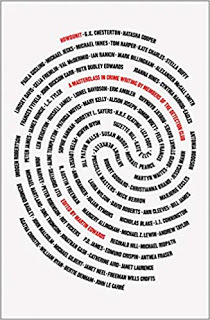
I was delighted to receive the news that Howdunit has been shortlisted for an Agatha award, following its recent nomination for an Edgar award. This is the third time a book of mine has featured in the Agatha nominations and it's all the more pleasing given that, as a result of the pandemic, members of the Detection Club who contributed to Howdunit have not been able to meet in person for more than a year. We are collectively honoured by the nomination!
I was also pleased to see the names of a number of friends in the list of nominees, including but not limited to Art Taylor, James Ziskin, Catriona McPherson, Lori Rader-Day, and Shawn Reilly Simmons. It's especially gratifying to see Sheila Mitchell's biography of her husband Harry Keating in the list. I contributed an appreciation to that fine book and recommended Sheila to her excellent publishers, Level Best Books. Not that I realised our books would one day be in competition for an award, mind you!
It is all the more frustrating that, once again this year, I won't be able to attend Malice in person. However, the organisers have come up with a fascinating online alternative. This is More than Malice, which will take place from 14-17 July. A wide range of stellar guests will be taking part. In addition, I shall be involved in an event focusing on Golden Age detective fiction with a number of lovely colleagues. More details will be available soon.
The pandemic has made life difficult for all events organisers - including those of us who are involved with Alibis in the Archive, which will also take virtual form this year, in October. But the efforts that everyone is making to provide entertaining alternatives are admirable, and whilst an online event is not quite the same, it is far, far more enjoyable than sitting at home on one's own thinking about what might have been.
March 29, 2021
Heartstones - 1996 ITV review
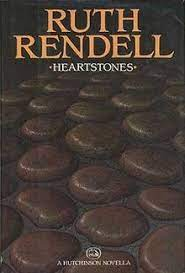
Heartstones began life as a novella by Ruth Rendell. I remember that it was published along with a novella by a younger writer, Helen Simpson (no connection with the Helen Simpson who wrote crime int the Thirties). I read the story when it first came out, way back in 1987. I remember enjoying it - I was a very big fan of Rendell, and at that time she was at the peak of her powers - and I believe I reviewed it for a magazine.
I didn't, however, see the TV version which came along as part of the Ruth Rendell Mysteries anthology series in 1996, and it's taken until the lockdown to repair that omission. The script is by Guy Meredith, and although the decision to turn the story into two episodes of over fifty minutes each mean that there is a bit of padding, overall it's a production which stands the test of time pretty well.
The cast is top-notch - there is even a small part for Idris Elba, playing a young pest controller. Anthony Andrews plays Luke, a handsome canon at a lovely cathedral (I gather the production was filmed at Winchester). His wife has recently died after suffering from cancer, although as the story begins, it seems there is a possibility that she may have been poisoned.
We see events through the eyes of Elvira (Emily Mortimer), the elder of Luke's two daughters. She and her sister Spinny (Daisy Haggard, whose father Piers was the director) have a close relationship, and they are devoted to Luke. When Luke falls for another woman, however (played by Helena Michell), tensions mount and it is foreseeable that there will be fatal consequences. This isn't one of Rendell's best-known stories, but it's pretty good and well worth watching.



